|
The second trip across in March 1944 was very similar to the first, but the
USS Enright's third trip home from Londonderry, she suffered her first
tragedy. On April 16, 1944, she was ordered out from the
anti-submarine screen to intercept an unidentified ship and divert it from
the convoy. A thick fog reduced visibility to about 500 yards.
At 0906 the USS Enright collided with a Portuguese freighter, the S. Thome
(English translation "Saint Thomas"). After the
collision, the USS Burke (DE-215) and the
USS Weber (DE-675) came to the aid
of the USS Enright. Only slight damage was sustained by the freighter,
but the USS Enright was crippled with a 9 degree list to port, a 65-foot
hole in her port quarter, with all living compartments flooded.
As a
result of the collision, a crew member of the USS Enright,
Carl Augustus
Mims, SF3/c USN, was lost at sea. The USS Enright limped into New York and
entered the Brooklyn Navy Yard (ap) on April 17, 1944. It required
thirty days of Navy Yard availability to get her repaired and ready for sea
again.
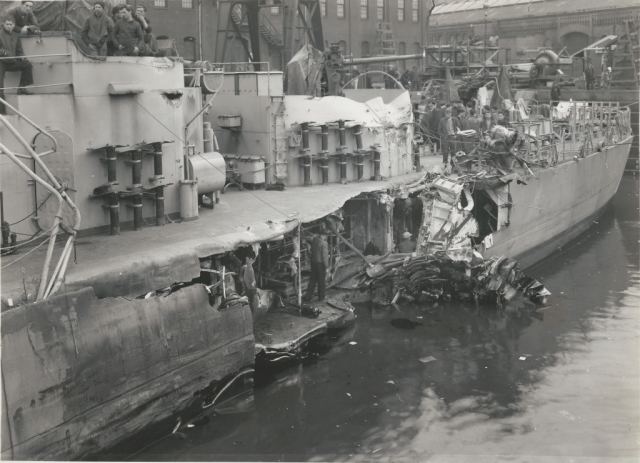
USS Enright at Brooklyn Navy Yard for repairs. Apr
17, 1944
National Archives photo: F644C6010
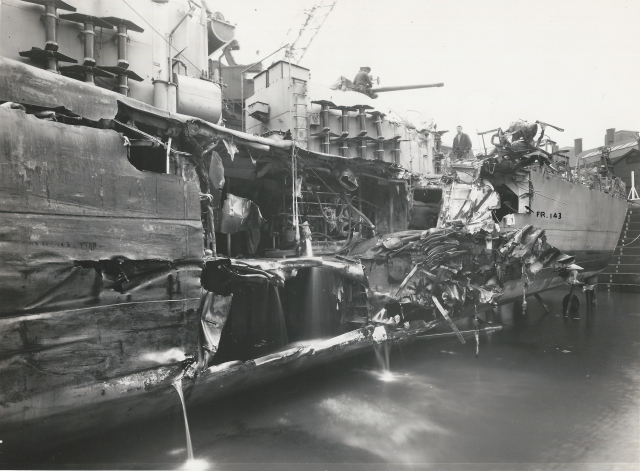
USS Enright at Brooklyn Navy Yard for repairs. Apr
17, 1944
National Archives photo: F644C6006
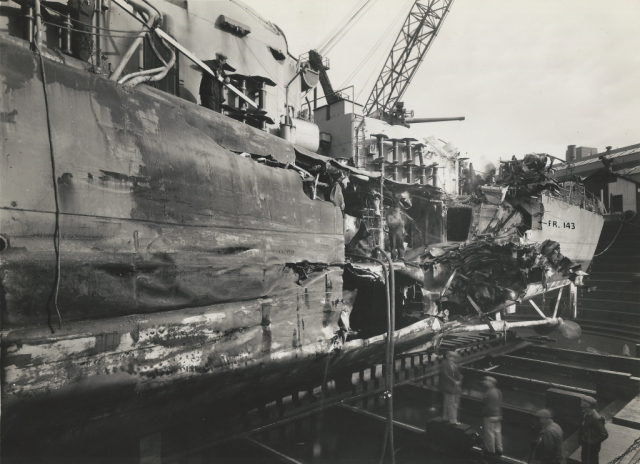
USS Enright at Brooklyn Navy Yard for repairs. Apr
17, 1944
National Archives photo: F644C6009
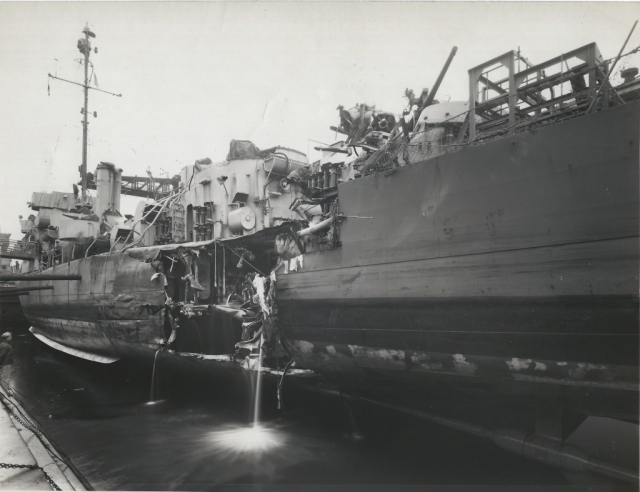
USS Enright at Brooklyn Navy Yard for repairs. Apr
17, 1944
National Archives photo: F644C6008
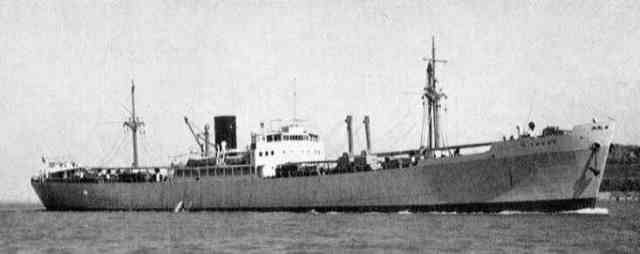
S. Thome, undated photo
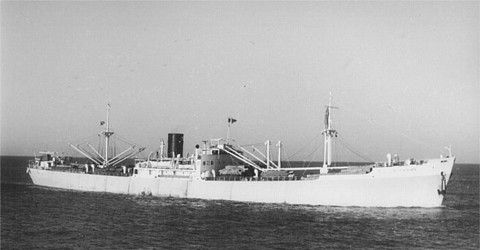
S. Thome, later undated photo
Eyewitness Account - Al Green, sonarman
April 16, 1944
We were at general quarters (GQ). A target had been detected on radar
moving towards our Eastbound convoy. This was early on the 08-12
watch. At this point we did not know what it was. It could have
been a submarine, so our depth charges were set for a possible attack.
The convoy had just come out of a storm, not uncommon in the North Atlantic. Our longitude coincidentally was similar to the Titanic, but several hundred
miles south in latitude almost on the thirtieth anniversary date of that
disaster. It was extremely foggy. Visibility was very poor and the sea
was in long, high swells-enough to make the Enright roll and pitch almost as
much as in the storm from which we just emerged, but this was life and
commonplace on a DE.
Another escort vessel was dispatched to intercept the target but couldn't
find it. It was moving directly towards the convoy. As far as I
know, no one knew at this time, what type vessel it was. Visibility
was still down to nothing. Despite the log listing the target as a
merchantman, there was no way of knowing this since it was just a blip on
the radar screen.
In the sonar hut we had no contact at this time. Moving in the
opposite direction of the convoy it would have caused bedlam and potential
destruction in the convoy. The Escort Commander [Commander Adolfe
Wildner], on another DE, (he had been
the previous captain of the USS Enright), ordered the Enright to stop it at
all costs. Radar was reporting the target, and sonar finally had the
target with a very clear echo, but the visibility was still very poor.
Our captain, unfortunately was over his head. Working on the bridge,
and hanging around that part of the ship between watches, it had been
obvious to me that he should have had a shore job. (This he did get
after the collision hearing.)
Another sonarman was assigned to the echo ranging shack. We rotated
assignments for GQ. My assignment was other sonar equipment at this
time, so it was possible for me to jump from the Sonar Hut to the flying
bridge, a distance of three feet, and reinforce our report.
Suddenly, like an apparition in the port bow, the freighter appeared out of
the fog. It looked like the Empire State building heading towards the
bridge of the Enright. The skipper froze. Fortunately, our
Executive Officer
Lt. William Folkes, shouted "we are on a collision course", took command,
and by adjusting the engines and the course of the ship, saves us from being
sliced in two, probably killing anyone on the bridge, the nerve center of
the DE.
We did collide, and a 65 foot hole occurred on the portside, flooding a
number of compartments. The ship was about 306 feet in length, so 65
feet was considerable. We really thought we would be abandoning ship,
but accolades went to the damage control team. They were well trained.
Unfortunately, one sailor, Carl Mims, was knocked overboard by the jar.
Almost simultaneously, a depth charge set for a submarine attack was jarred
and fell into the sea, exploding at it's designated depth. No person
in the sea could have survived the percussion. Another depth charge
was loosened from a rack and fell on the legs of Bill Thompson, a Yeoman.
After a series of operations he was discharged, went to Notre Dame, becoming
an engineer.
The scuttlebutt continually passed around was that Portugal,
a neutral nation was supplying the subs with diesel. I guess any ship
could disguise their cargo. None of these facts were confirmed to us.
When we thought we might abandon ship, I foolishly thought that the DE
standing about a half a mile would pick us up in no time, and we would be
heroes.
The North Atlantic is about three months behind the season so
April where we were had January weather. No human could last more that
about 15-20 minutes in that. At a recent reunion, I spoke to Tom
Kelly, a torpedo man. This group was also responsible for the depth
charges. He told me they had been set, and had the Enright gone under,
they would have exploded. This could have killed anyone in the water in the
vicinity.
Carl Mims, our one death was probably killed by what I
remembered was one explosion, but actually were three. At the very tip
of Manhattan is a large memorial for all Navy Men lost in the Battle of the
Atlantic. Carl is listed there.
When the Enright limped into port with a 65 foot hole on the port side,
traffic stopped on the first two bridges to look at us. It was a
sight.
It took about a month to repair the ship. We lived in a housing
project near the Brooklyn Navy Yard. The US Navy had commandeered the
facility for lucky sailors like us. Long leaves were given to the
crew, staggering the dates so that ship's business could continue during the
repairs. It set our convoy duties back about a month, otherwise we
would have been in the UK in time for D-Day. It is purported that the USS
Rich-a neophyte, having been in Londonderry, on its first crossing,
substituted for us. We think we were the ship the records stated "was
not available for the invasion." The Rich screened for a battleship
which was bombarding the cliffs at Omaha beach, protecting it from
submarines, when it hit mines (two or three), went down, with a very large
loss of lives.
- Al Green, September 28, 2007
Ship's Log April 15 -18, 1944
Note: the ship's log from the
USS Burke (DE-215) is interspersed with
the USS Enright's log. The USS Burke entries are
highlighted in green.
April 15, 1944
0800: USS Burke log: position 38-10
N, 62-36 W
1200: USS Burke log: position 37-59
N, 63-24 W
2000: USS Burke log: position 37-24 N,
66-02 W
April 16, 1944
0000: Steaming with Task Group 21.7 escorting convoy UC-18 on course
254 degrees T [true north] at 14 knots. On station bearing 300 degrees
relative from the guide at 5000 yards. War cruising watches and
material condition "Baker" set. No. 1 and No. 2 Boilers in use
0040: Convoy changed course to 279 degrees T
0100: Convoy changed course to 305 degrees T
0400: Steaming as before
0630: Exercised at general quarters
0652: Convoy changed speed to 13 knots
0711: Secured from general quarters
0800: USS Burke log: position 38-00
N, 68-56 W
0800: Steaming as before
0831: Radar contact reported by USS Weber bearing 285 degree T (true
north), distance 12-1/2 miles
About 0900: Executed general quarters upon orders of CTG (Commander Task Group) 21.7. Heavy fog, visibility about 500 yards. CTG. 21.7 instructed USS Weber to divert a merchantman heading into
convoy on reverse course of convoy. USS Weber reported unable to
identify or divert merchantman, merchantman had already passed him.
CTG 21.7 instructed USS Enright not to let the merchantman come between
the Enright and the convoy. CTG 21.7 directed USS Enright to sound
fog signals.
About 0903: whistle would not operate
About 0904: merchantman sighted one point off port bow on collision
course
0905: Full speed astern, hard right rudder
0905: USS Burke log: all ships in convoy
and escorts ordered to stop CTG 21.7
0905 1/2: Full speed ahead, hard left rudder
0906: Collided with Portuguese freighter, later identified as S.
Thome, on port side aft of engineering spaces. All engines stopped.
Three living compartments C-201-EL, C-202-L, C203-L, flooded.
Commenced fog signals. Three depth charges exploded at about 300 feet.
Listing to port 9 degrees. Freighter lay alongside for about one
minute and then backed away. Shoring commenced on after bulkhead of
after engine room, forward bulkhead of after steering compartment, and
forward bulkhead of compartment C204-AL.
0914: USS Burke log: ordered by CTG 21.7
to go to the aid of the USS Enright, who was rammed by an Portuguese tanker,
the "S. Thome", not in Convoy UC-18 in an attempt to divert her from the
path of the Convoy.
0921: Tested engines satisfactorily. Port motor had
overexcitation
0922: Rudder and steering control tested satisfactorily Gyro
checks accurately
0928: Degaussing shorted out and secured
0945: Secured fog signals. Radar out of operation with burned
out tubes. One man reported with compound fracture of the tibia of the
left leg: Thompson, William G., Y3c USNR, 205 21 39. Patton,
Melvin PhM1c administered First Aid.
0945: USS Burke log: standing off
starboard bow of USS Enright who is dead in water
0954: USS Weber came close aboard port side, offering assistance
0955 (about): Radar back in operation
1013: USS Burke log: secured from General
Quarters
1025: Steaming at various speeds on 305 degrees T
1030: USS Burke log: Ordered by CTG 21.7 to take station #2
Nan, after being relieved by the USS Weber from assisting the USS Enright.
1053: Commenced fog signals
1055: Ceased fog signals
1100: Secured from general quarters
1104: All divisions mustered on station. One absentee: Mims,
Carl Augustus, 829 27 56 SF3c USNR. Daily inspections made of forward
magazines and smokeless powder samples. Conditions normal.
Unable to reach after magazines.
1116: USS Weber took station ahead of USS Enright at 1500 yards
1130: USS Burke log: on station nan
1135: Fog lifted
1200: USS Burke log: position 38-17
N, 69-28 W
1200-1600: Steaming as before. Gradually increased speed to 15
knots on both engines
1600: Steaming as before
1717: Changed base course to 298 degrees T
1800: Ship's clocks turned back one hour to zone plus 4 time
2000: USS Burke log: position 39-41
N, 71-58 W
2000: Steaming as before
2314: Light bearing 35 degrees T, 5 miles identified as fishing craft
April 17, 1944
0000: Steaming with the USS Weber on base course 298 degrees T, base
speed 10 knots. Material condition "Baker" set forward of frame 60 and
condition "Able" set aft of frame 60. No. 1 and No. 2 boilers in use.
War cruising watches set. Carrying a port list of 12 degrees due to
the damage caused by the collision.
0327: Sighted and identified USS Resolute (AT) and SC1013
0400: Steaming as before
0530: Sighted buoy bearing 270 degrees T and started up swept channel
0730: Steaming at various courses up swept channel
0800: Steaming as before
0830: Land sighted 312 degrees T, 8 miles
0839: Ambrose
Lightship sighted
0855: Stationed special sea detail
0900: Whistle and siren tested satisfactorily
0915: Coast Guard pilot came aboard
0922: Passed Ambrose Lightship. Steaming at various courses and
speeds up Ambrose channel.
0955: Made daily inspection of magazines and smokeless powder samples
forward. Conditions normal.
1044: Passed through gate
1155: Yard tug came alongside. Yard pilot came aboard.
1216: Moored port side to
USS Spencer at Berth 5, Pier D,
Brooklyn
Navy Yard (ph ap) New York
1230: Divers commenced inspection of damage
1251: In accordance with Form "G", Thompson, William George 205 21 39
Y3c was transferred to Brooklyn Navy Hospital
1420: Lt. (jg) Mark A. Richards, D-V(G) USNR, 185095, reported aboard
for duty per basic orders from Bupers 3134-SLP-3 dated 26 February 1944
1432: Prepared to get underway for Drydock No. 1 without ship's power
1433: Underway
1452: Stern passed the caisson of Drydock
1505: Bow passed the caisson
1600: Underway as before
1618: Resting on keel blocks
1715 Receiving steam, fresh water, electric power and telephone from
the shore
1725 Patton, Melvin J. PhM1c reported that Kostyack Edward 822 38 18 S2c,
had Xray taken of knee which was injured at time of collision 16 April,
1944. Recommended he be transferred to hospital.
1845: Commenced moving ammunition off ship
2000: Resting on keel blocks as before
2225: In accordance with Form "G" Kostyack Edward 822 38 18 S2c,
transferred to Brooklyn Navy Hospital, with diseased condition of the knee
caused by fall as a result of collision 16 April 1944.
April 18, 1944
0000: Resting on keel blocks in Drydock No. 1, New York Navy Yard,
Brooklyn, N.Y. Receiving fresh water, steam power and phone services
from the dock.
0230: Completed removing all ammunition from ship
Related information
Official Letter resulting
from the of collision at sea.
Lat/Lon coordinates: screenshot from Google Earth
Lat/Lon coordinates: Google Earth
(requires Google Earth installation
on your computer)
Ship's Log
excerpts, April 7 & 11-18, 1944
|